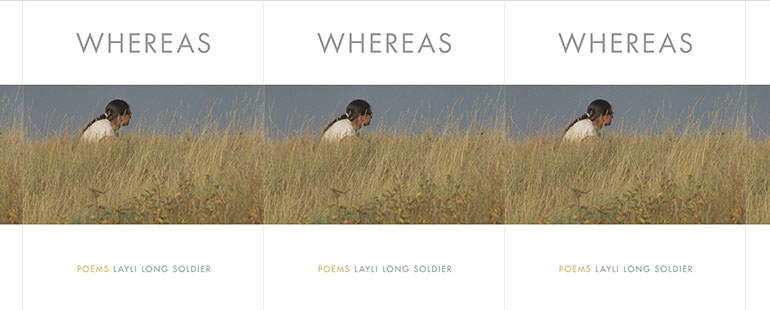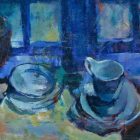The Lap as Site of Resistance in Layli Long Soldier’s Whereas

One summer afternoon when I was pregnant with my second child, I was lounging in the grass at the park watching my two-year-old daughter play when another little girl—a girl I didn’t know—came over and sat down in my lap. When my daughter noticed her seat was taken, she stood a bit apart from us, confused and angry. “It’s ok,” I said to her, to myself, to the girl on my lap. I wondered if I should wrap my arms around her, rock her, or instead come up with some excuse to move her, to remove myself from her. The three of us paused like that for a minute, maybe two, before an older woman appeared, made an exasperated face, and said, “Oh there you are!” and, “Oh you poor thing!” I wasn’t sure who she meant—me or the girl. And just like that, the girl was gone.
I told the story to anyone who’d listen, wondering all the while if people found it boring, if I’d become just another woman with kids, wrapped up in unimportant things. But the story is important: it illustrated a change in me. My body had become a site of potential connection and comfort. I might even say the little girl I didn’t know read my body as a space for children generally and a space for her specifically, so she fell into my lap. I remember feeling lucky to have had been chosen by her, lucky that my lap offered her something transformative, that it was doing a certain kind of work.
When I say lap, I might mean one portion of a complete trajectory—integral to the whole but inferior on its own. When I say lap, I might mean luck, as in, it just fell into my lap. What lands in the lap might not be reached for; the lap offers passive acceptance. My friendship with a pair of artists at the Columbus College of Art and Design also seems to have fallen into my lap. They’ve asked me to collaborate with them on a piece they call Lap-work. One woman curated an assemblage of her grandmother’s diaries, journals, and letters, then embroidered passages from them onto muslin squares; the second woman took her children’s outgrown clothes and sewed into them a furious accumulation of thread meant to show time passed in worry, in boredom, in the frantic need to do something. Both pieces meditate on time—the lack of it, the tireless recording of it, the juxtaposition of important and unimportant events in time, time set aside for the self in the midst of self-less time.
But the larger project—Lap-work—also documents other artist/mothers’ struggle to make time for their creative work, noting the interruptions they experience in time and the changes they’ve made to their spaces in order to accommodate both mothering and art-making. Traditionally speaking, art is created in privileged spaces (the studio, the office), and privileges certain materials (oil paint, written text). Spaces and materials are prone to hierarchies, their meanings defined against other meanings, in opposition to and in contrast with other spaces, other materials. Lap-work, however, doesn’t require expensive or potentially dangerous materials; it doesn’t require much space. It can be worked on between parenting duties, on-the-fly, and, of course, on the lap.
My own contributions to Lap-work recognize the setbacks and opportunities mothering while art-making and art-making while mothering creates in my own life and in the lives of other writers. Similarly, Layli Long Soldier’s 2017 poetry collection, Whereas, is—beyond its brilliant depiction of colonialism’s legacy—also a book about liminal spaces and stolen time, by which I mean, the dilemma of the mother/maker or mother/artist. Long Soldier sees her body as “a field of action” (to quote William Carlos Williams), and her lap as a locus of activism. Long Soldier writes:
At a ceremony
to honor the Diné Nation’s first poet laureate, a speaker explains that each People has been given their own language to reach with. I understand reaching as active, a motion. He offers a prayer and introduction in heritage language. I listen as I reach my eyes into my hands, my hands onto my lap, my lap as the quiet page I hold my daughter in. I rock her back, forward, to the rise of other conversations
about mother tongues versus foster languages, belonging. I connect the dots.
As a member of the Oglala Lakota Nation, Long Solider’s concerns regarding time and space are historical in nature, by which I mean long-standing, wide-spread, deeply embedded. While Whereas serves poetic response to 2009’s Congressional Resolution of Apology to Native Americans, its invocation of the lap—and its smallness and intimacy—as a site of creative resistance also reminds us that what we traditionally consider to be woman’s work is, in fact, the work of language acquisition and, consequently, community-building, identity creation, and political resistance. Emilie Buchwald tells us that “children are made readers on the laps of their parents.” Long Solider, however, wonders: readers of which narratives, whose histories? For her, the lap becomes a “quiet page” and her daughter the text. The physical and linguistic motions of “reaching” and “rocking” serve an alternative narrative.
Long Soldier couches her meditation on language in a dialectic between philosophy (the esoteric) and family (the physical). She says,
I rock in time with references to a philosopher, a master language-thinker who thought of his mother too. Mother-to-child and child-to-mother relationships. But as this philosopher’s mother suffered the ill-effects of a stroke, he wrote, I asked her if she was in pain (yes) then where? […she] replies to my question: I have a pain in my mother, as though she were speaking for me, both in my direction and in my place. His mother, who spoke in his place for his pain and as her herself for her own, did this one-and-the-same. Yet he would propose understanding the word mother by what a mother is not, the différance.
The “master language-thinker” she’s referring to here is Jacques Derrida. In 1963, he used the word différance to describe (imperfectly) the imperfections in language (a concept perhaps illustrated in the italicized portion of Long Soldier’s passage about Derrida’s ill mother)—what we might call a slip of the tongue or even lucky, as in, this example of différance just fell into my lap. We can’t conceive of the word mother without the word child, but what’s intriguing here is Derrida’s emphasis on space and time, how they seem to collapse for his mother and for him until her subjective reality segues into his own. She is “in his place” and speaking “for his pain,” the pain he experiences as his mother’s child.
Still inside the creative space of the lap, Long Soldier goes on:
Forward, back. I lift my feet
my toes touch ground as I’m reminded of the linguistic impossibility if identity, as if any of us can be identical ever. To whom, to what? Perhaps to Not. I hold my daughter in comfort saying iyotanchilah michuwinku. True, I’m never sure how to write our language on the page correctly, the written takes many forms
yet I know she understands through our motion. Rocking, in this country of so many languages…
If part of Derrida’s agenda with différance is to expose the hierarchical aspects of difference and deferment, then we are, as Long Soldier says, “identical to Not,” difference and deferment perpetuating themselves infinitum; Long Soldier is made by language perpetually different while the Apology and its real, felt consequences are perpetually deferred by language. What’s real and felt is the body, telling us, “If I’m transformed by language, I am often / Crouched in footnote or blazing in title. / Where in the body do I begin.” Of course, by body she means both the heart of the argument and the physical self’s “field of action,” site of artmaking, site of mothering. What’s real and felt is the rocking. What’s real and felt is the reaching. What’s real and felt are “the grassesgrassesgrasses…in the mouth.” We must “make room for them,” she urges us (emphasis mine).
Virginia Woolf famously argues that the woman artist must have “a room of her own” in order to succeed, but Layli Long Solider challenges the very notion of room. What if the only room the artist/mother has is her lap? What if, by room, we mean room’s lack, its absence? In an artistic context, Derrida might define the word lap against other words like studio and office, and by virtue of its inferior stature, its less-ness—as in less important, or self-less—it becomes coded as a woman’s space, a place for women’s work, for embroidery, childcare, or storytelling.
The story of the U.S.’s colonialism can’t accommodate her daughter the way Long Soldier’s lap can. If the lap’s intimacy offers opportunity, then the linguistic box white patriarchy builds around Long Solider herself forecloses it. In the third part of Whereas’ opening sequence, for example, Long Solider creates a visual box out of the text “This is how you see me the space in which to place me,” a phrase she construes in various ways then places on the page so that the typographical box remains empty and terrifyingly white at its center. This isn’t the lap’s “quiet page,” but rather the trace of an absent body, a confiscated space the speaker is both locked out of and trapped inside. The implication is violence.
The lap, on the other hand, can be defined in relation to violence, as in its counterpoint. It’s a space occupied by love. Time in the lap—as any parent can tell you—is fleeting, but its work is timeless. Perhaps Long Solider is asking for the kind of physical intimacy lap-work engenders—an alchemic process by which we reach against the odds language stacks against us.



